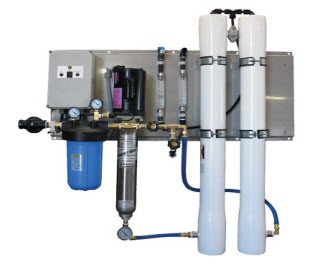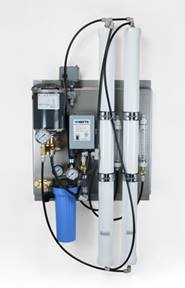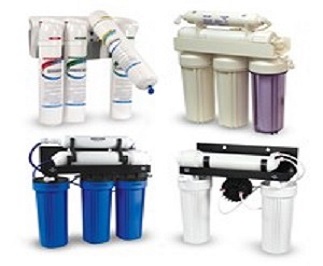

Access to clean and pure water is a right of every human on the earth. There may be abundant water sources around you, including well water, ponds, streams, rivers, and other water bodies. However, water from these sources is unsuitable to use due to contamination and several reasons. Water may contain dissolved solids, microbes, and several other contaminants, which if left unaddressed may harm humans and equipment through which they are transported to your homes or facilities where they may be used. To avoid this, the dissolved solids in water is removed using RO filters. At Intec-America, we provide whole house and under sink reverse osmosis water treatment systems. Our Nelsen Commercial Series of Reverse Osmosis Systems and Watts – R4x40 RO Series have been successfully installed in hundreds of homes and commercial facilities across the US. Get in touch with our team to discuss your water treatment requirements!
Reverse osmosis is the opposite of osmosis, which is why the name. Osmosis is a process where the solvent is made to pass through a semipermeable membrane from low to high solute concentration, however, reverse osmosis is quite the opposite. In later, water moves from the region of high to low solute concentration.
Generally, a reverse osmosis water filtration system features a fine semipermeable membrane with a dense filter layer. Water is pushed through this membrane at a certain pressure and the filter holds back salts and impurities. The water pressure is set to overcome the osmotic pressure induced by solvents. Reverse osmosis helps remove dissolved ions such as chlorides, sodium, as well as metal ions up to 0.001 microns. This process usually differs from the regular filtration process, where the filters collect the impurities. In this, the impurities are held back and clear water flows to the storage tank. Then, the contaminants are flushed to the drain using water.
These systems are generally connected to only one faucet in your house. They are installed under the sink, thus, the name. These systems use incoming water pressure to push water through the membrane. Although the membranes can remove inorganic solids, it is recommended to remove any harsh sediments and hard minerals from the water before feeding to the membrane. This would help improve the life of the membrane. Sometimes water may become sour or acidic due to the mineral removal and this is where the acid neutralization may be needed. Today, you can find a 4-stage RO system, which features sediment, pre-carbon, RO membrane, and post carbon TCR filter. This means that water passes through 4 stages before getting collected in the tank. In the first stage, the first filter removes sediment and dirt, which may affect the system. The carbon filter removes chlorine, which may attack the system, whereas the RO membrane will remove 95% to 98% of impurities in the water. The TCR filter will help remove remaining impurities from water, thereby improving its taste and aesthetic appeal.
These systems are designed to support a large number of faucets in your home or commercial facilities and have large membranes than PoU systems. Whole house RO systems feature large membranes, and use a booster pump to increase the water pressure needed for the process. The pumps rush the water the membrane. Unlike PoU systems, the whole house systems require large investments. You would require a storage tank to store the treated water. Sometimes, an additional booster pump may be required. Many whole house or point of entry systems are designed to reduce the rejected water produced during the process. They feature advanced water recovery features to minimize water waste.
Reverse osmosis water filters are known to tackle the following types of contaminants:
Water sourced from city water systems and wells may be laden with inorganic minerals that can affect the smell and taste of water. These systems are designed to remove inorganic matter from the water and improve the taste of water. Our body cannot digest inorganic matter. Thus, removing inorganic matter will not harm us in any way. Although water may be one of the sources of minerals, it is not enough. Food is the source of minerals in our body and they help us stay healthy.
Generally, a RO membrane in the reverse osmosis water filter may last 2 to 5 years, depending on the brand and other factors. In some cases, it may wear out little after a year of use, depending on the type of particles removed by these filters. You can easily extend the use of membrane by cleaning it timely. The following pointers will help you identify the right time for cleaning.
If you notice any of the following symptoms, then it is time to clean the membrane:
What is Whole House Reverse Osmosis Water Filtration System? A whole house reverse osmosis system (Point-of-entry, POE) provides the best water quality to every faucet in a home. Reverse osmosis is a mechanical filtration method that is used to remove impurities and the ionic level and other molecules from water. This method utilizes pressure to force a solution through a semipermeable membrane. Larger molecules are rejected resulting in the highest quality water entering your home. Keep in mind, a whole house RO is far more than just a reverse osmosis system. It is complete system which may include pretreatment, a reverse osmosis system, post treatment, sanitation, and finally water storage with a booster pump. Generally, a whole house reverse osmosis system is positioned at the entry point of pipe that supplies water to your home. The RO system itself is comprised of a booster pump, pre-filter, vessel(s) that contain the reverse osmosis membrane(s), solenoids, and a control panel. The reverse osmosis membrane is made of tightly wound sheets containing small microscopic pores. These small openings reject approximately 98% of the dissolved inorganic and organic matter and is responsible for its high filtration capability. This makes it capable of filtering contaminants like copper, chromium, uranium, boron, arsenic, lead, silver, nitrates, and sodium. Although many of these metals are beneficial for human body, when in excess they can cause severe harm. There are very few filtration techniques as efficient as a RO system that can eliminate these ions completely. Owing to its high purification capabilities, whole home reverse osmosis systems are becoming a favored choice over distillation and deionization techniques for water purification. POE or whole house water osmosis systems (700 GPD to 3,600 GPD on average) are mainly used for residential water purification applications. These are actually small commercial...

Many of the homes being built today come with an under sink water filtration system. However, not all under sink water filters are the same. Most will improve the taste of the water or perhaps remove chemicals such as chlorine. However, simple under sink water filters will not remove toxins such as arsenic, lead, perchlorates, and trihalomethanes. An under sink reverse osmosis water filter system is a low-cost option that can effectively remove 95% – 98% of contaminants found in water. Under Sink Reverse Osmosis System offered by Intec America Intec offers many options for under sink reverse osmosis systems. These point-of-use (POU) systems are generally installed inside a cabinet or basement where it is out of site and come with a dedicate faucet that provides highly purified water for drinking and cooking purposes. An under sink reverse osmosis system is very popular because they are easy to install, maintain, and they are highly effective purification system. Benefits of an Under Sink Reverse Osmosis System Include: Toxin removal Improved taste of drinking water Improved taste of any food prepared with water Cost savings over bottled water Your under sink RO system can provide treated water to a refrigerator or icemaker Under Sink RO System Installation Guide This under-sink water purification system uses the incoming water pressure to push water through the reverse osmosis membrane. Before the water enters the membrane, the process requires the removal of sediment and oxidants to increase its life. Under sink home reverse osmosis system(s) generally have 2, 3, 4, or 5 stage options. Meaning, 1 stage includes the membrane and the remaining stages indicate the number of under sink water filters(s). Intec recommends a minimal of a sediment (stage 1) and carbon (stage 2) filter before the membrane (stage 3) and a post carbon...